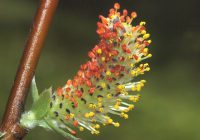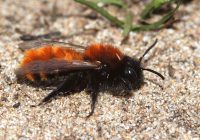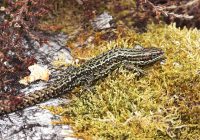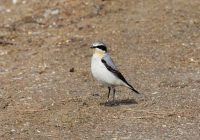Dr Phil Smith’s Wildlife Notes
April 2013
Continuing March’s theme, April 2013 was the coldest since 1989, particularly so in the first two weeks and was also excessively dry, with only about 70% of normal regional rainfall. The ongoing drought contributed to a spate of fires in the dunes at the end of March, these being driven along by strong north-easterly winds. The most serious was at Ravenmeols and Cabin Hill frontal dunes, extending for over a kilometre between Albert Road and the boundary of Altcar Rifle Range and covering an estimated 11.5ha (28 acres). Visiting the blackened aftermath on 5th April, it was clear that this was the largest fire I had seen on the coast in 44 years.
Fortunately, the burn seems to have been quick and superficial, plant stems even an inch down in the sand being barely singed. A couple of weeks later, there was already plenty of regrowth and the dunes were beginning to green up again by the end of the month. The main worry concerned several Sand Lizard colonies in the affected area. Although, the adults would still have been hibernating below ground, on emergence they would be faced with little cover and food and a high risk of predation. No doubt there will have been some unhappy Rabbits as well. Invertebrates may also have suffered, including the overwintering stages of Grayling and Dark Green Fritillary, as well as commoner butterflies.
Most of our wildflowers seemed to be about three weeks late. For example Patricia Lockwood joined me on 10th to check out the nationally rare Early Sand-grass (Mibora minima) on the dunes west of Southport Marine Lake. We found it in great abundance and in full flower, though it normally appears in mid-March. Pat spotted a group of plants lacking the usual red pigment (anthocyanin). Although this kind of mutation is known to occur in several grasses, it seems not to have been reported before in Mibora.
Also late were the catkins on the 30 or so different willows we have in the dunes. My favourite is Salix × doniana, the red-tinged male catkins of this rare hybrid being particularly spectacular. Also stunning are the catkins of Violet-willow and Siberian Violet-willow, these being non-native and probably planted where they occur on the coast.
Few insects were out and about in the cold weather, though the occasional Peacock and Small Tortoishell emerged from hibernation on sunny days. I was pleased to find both the Common and Slender Ground-hopper on slacks at Birkdale on 20th, while the first Northern Dune Tiger Beetles were active on the frontal dunes. Vernal Mining Bees had made an appearance by 20th, though last year they were seen in mid-March. I also bumped into some Tawny Mining Bees on Freshfield Dune Heath on 23rd. The females are bright orange and, although fairly common nationally, this solitary bee had not been recorded on the heath before. At the Sand Lizard re-introduction site, a strongly-marked male Common Lizard basking on a log might easily have been mistaken for the rarer species.
Migrant birds were also late but arrived in a rush around 12th when I counted 15 Northern Wheatears on the shore at Birkdale. A visit to Cabin Hill on 17th was productive, with three Sand Martins and seven Swallows hawking over the wetlands, while three Willow Warblers were singing nearby. I was pleased to see a Water Rail but the highlight was four Garganey (three males and a female), a small migrant duck that I had never recorded before at Cabin Hill. Two days later, a flock of 46 White Wagtails made a fine sight on Ainsdale beach.
A walk through the Ravenmeols woods on 21st produced Blackcap, Chiffchaff, Great Spotted Woodpecker, Jay, Goldcrest and Siskins, all of which were expected. A flash of red then alerted me to something out of the ordinary and I was soon watching a superb male Redstart flitting between the trees. However, the rarest bird seen during this period was a male Serin claimed at Seaforth Nature Reserve on 20th.




